Differences Between Tadpoles & Frogs
Young frogs hatch from eggs in the form of aquatic larvae called tadpoles. As they move through their life cycle, they become froglets before developing into fully formed adult frogs. There are many adult frog and tadpole differences that are readily visible to the eye, such as the fact that tadpoles have a tail, while adult frogs have four legs and no tail. There are some other less obvious differences to consider as well.
Frog and tadpole habitat
Frog and tadpole habitat
Frogs are amphibians. The Greek root of this word means "double life" and refers to the fact that amphibians, including frogs, can live both in the water and on land. This ability is true of adult frogs; however, tadpoles are different. They hatch from eggs laid in the water and haven't developed the ability to survive on land yet. Tadpoles live exclusively in the water.
Visible frog and tadpole differences
Visible frog and tadpole differences
Just by looking at a tadpole and a frog, you can easily see some of the differences. Tadpoles have a head and a long tail that allows them to swim and move in the water. They do not have legs like a froglet or an adult frog nor do they have fins like a fish.
Adult frogs, on the other hand, have four legs and do not have a tail. Their legs allow them to hop on water, but they don't lose the ability to swim. In fact, their streamlined body and webbed toes make them well adapted to life in the water.
Differences in respiration
Differences in respiration
Another of the frog and tadpole differences is in the respiration system. As tadpoles live exclusively in the water, they have gills that allow them to get oxygen from the water. Tadpoles also develop lungs, and they can breathe air from air bubbles near the water's surface.
When tadpoles develop into frogs, the gills are covered with skin, and their lungs develop to support life on land. Frogs breathe by gulping air, as they don't have a diaphragm or muscles to breathe as humans do. In addition, frogs can absorb oxygen through their skin. This allows them to breathe when they are in the water, and some species of frogs use this method of breathing almost exclusively.
Different dietary needs
Different dietary needs
Tadpoles and frogs enjoy different diets. When tadpoles are born, they will stay mostly immobile until they have fully consumed the egg yolk. They then enjoy a vegetarian diet of plant life and algae in the pond or body of water where they were born.
Adult frogs, on the other hand, are carnivores. Many species feed on a variety of insects, including grasshoppers, flies, and mosquitoes. Larger frogs may enjoy larger prey. Some frogs may eat worms, small snakes and turtles, and mice. Some species of frogs may even eat smaller frogs. Adult frogs have a large mouth and a sticky tongue that allow them to hunt successfully.
Adult frogs absorb water through their thin skin. This means that they don't need to drink water. While they can survive on land, they must return to the water to keep their skin moist.
Tadpole to frog transition
Tadpole to frog transition
When tadpoles develop hind legs and the lungs start their development, they are considered froglets. This is the intermediate step between tadpole and frog. Froglets can use their legs to hop on land. Froglets develop front legs, and their tails begin to shrink as the young frogs absorb the nutrients.
This transformation can happen quickly or over a long period of time. The length of the transition may depend on several factors, but the tadpole has the ability to speed the transition if the pond is dangerous for survival. Likewise, if weather conditions on land aren't hospitable to a young frog, such as if there is a cold snap, the transition from tadpole to frog may take longer.
